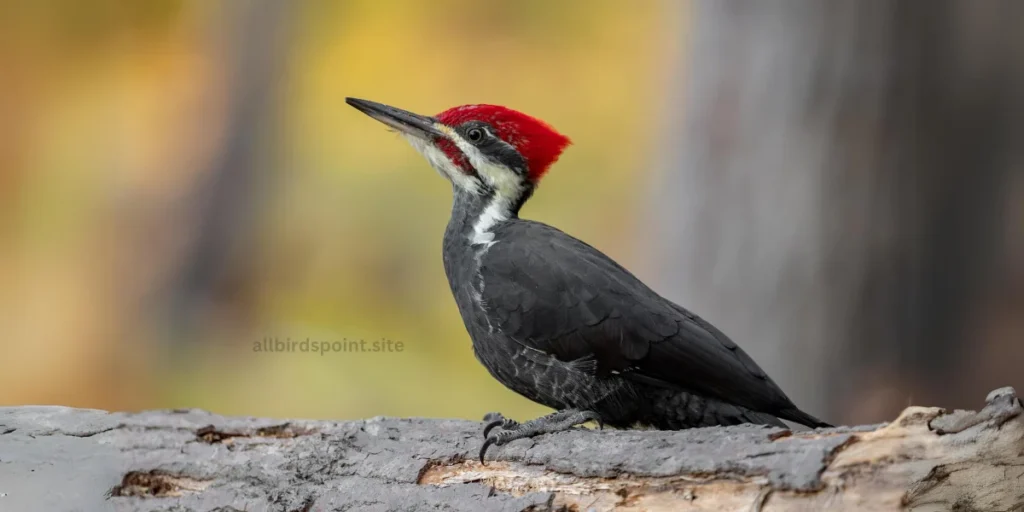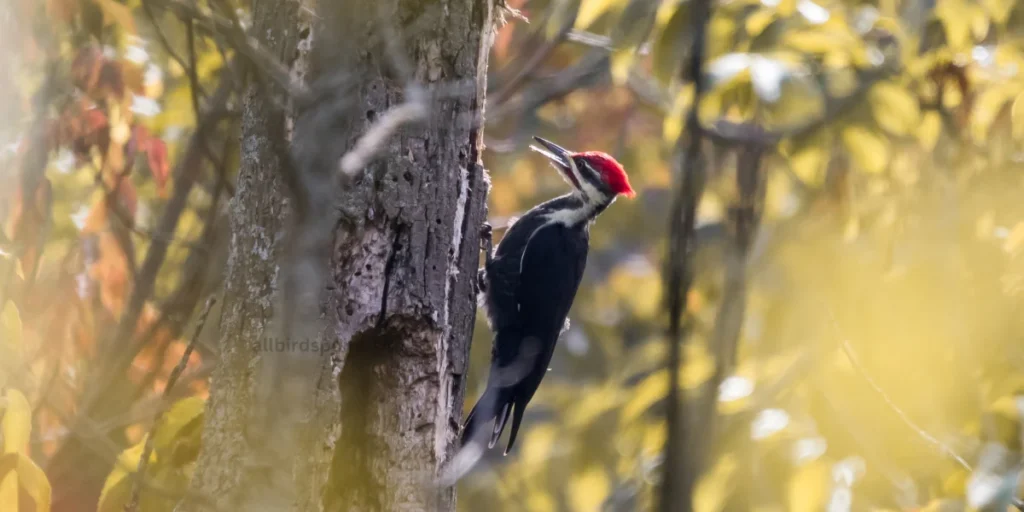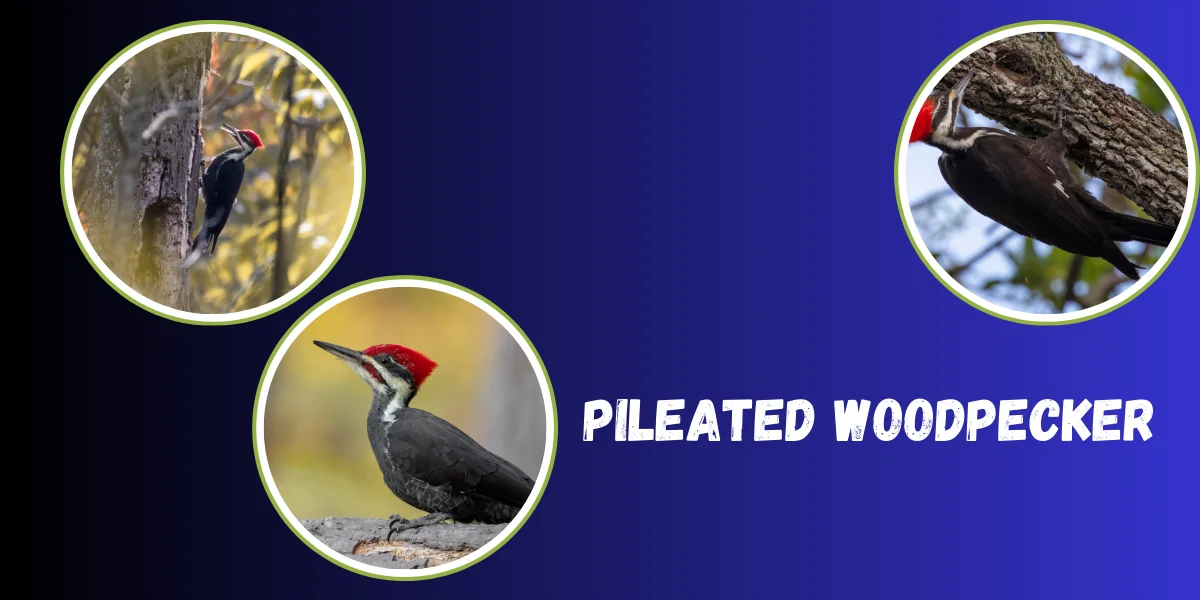The Pileated Woodpecker (Dryocopus pileatus) is one of the most impressive and large woodpecker species found in North America. With its crow-sized body, striking red crest, and loud calls, it’s hard to miss this remarkable bird if you’re lucky enough to spot one. This article will dive into the physical characteristics, habitat, feeding habits, fascinating adaptations, ecological importance, and conservation status of the pileated woodpecker. By the end, you’ll have a deep appreciation for this iconic bird of North American forests.
Physical Characteristics of the Pileated Woodpecker
The pileated woodpecker is visually distinctive due to its size and coloration. Below are some key features that make it stand out among other bird species.
| Physical Feature | Description |
|---|---|
| Size | Approximately 16 to 19 inches long, with a wingspan of 26 to 30 inches. |
| Weight | Typically weighs around 10 to 14 ounces. |
| Coloration | Mostly black with white underwings and a prominent red crest on the head. |
| Crest | Males and females both have red crests, though the male’s extends to the bill. |
| Sexual Dimorphism | Males have a red stripe on the cheek, called the malar stripe, while females do not. |
| Beak | Strong, chisel-like beak for drilling into wood. |
The pileated woodpecker’s large size sets it apart from most woodpecker species. It’s comparable in size to a crow and is one of the largest woodpeckers in North America. The bright red crest, especially on males, adds to its striking appearance, and its powerful beak allows it to excavate large holes in trees while foraging for insects.

Habitat and Range
Pileated woodpeckers prefer mature forests with plenty of large, standing dead trees (known as snags) where they can nest and forage. They thrive in deciduous and mixed forests, though they can also be found in coniferous forests, swamps, and suburban areas with mature trees.
Range
- North America: The pileated woodpecker is commonly found across much of North America, especially in the eastern United States, the Pacific Northwest, and parts of Canada.
- Migration: Unlike some bird species, pileated woodpeckers do not migrate. They are year-round residents in their territories.
These woodpeckers require large home ranges, and territory size can vary from 100 to over 1,000 acres, depending on the availability of food and nesting sites. In suburban areas, as long as there are mature trees for foraging, they have adapted well to human presence.
Feeding Habits
Pileated woodpeckers are insectivores, but their diet also includes fruits, nuts, and seeds. Their favorite prey are carpenter ants, but they will also consume other wood-boring insects and larvae. They forage by using their strong beaks to excavate large, rectangular holes in trees, often tearing apart decaying wood to reach insects inside.
| Food Source | Description |
|---|---|
| Carpenter Ants | The primary food source; they dig into dead wood to find these ants. |
| Wood-boring Insects | They also eat beetles and larvae found in decaying trees. |
| Fruits and Nuts | In addition to insects, they enjoy fruits like wild grapes and berries, and nuts like acorns. |
| Sap | Occasionally, pileated woodpeckers will drink sap from trees. |
The birds are particularly skilled at locating insects within decaying trees. Their large, powerful beaks and long, barbed tongues make them efficient predators of wood-dwelling insects. This foraging behavior helps control insect populations and accelerates the decomposition of dead trees.

Unique Adaptations for Survival
One of the most fascinating aspects of the pileated woodpecker is how it has evolved to withstand the enormous physical stresses of hammering into wood all day. The following adaptations protect the bird from serious injury, particularly brain trauma.
1. The Elongated Hyoid Bone
The pileated woodpecker has an elongated hyoid bone (sometimes referred to as its “tongue bone”), which wraps around the bird’s skull and helps absorb shock from repeated impacts. This feature is essential in preventing brain damage. The hyoid bone acts as a natural shock absorber, distributing the forces generated during drilling across the skull rather than allowing them to concentrate on the brain.
2. Spongy Skull
The bird’s skull has a spongy texture at the front, which helps absorb the force of the impacts when it pecks into trees. This feature is similar to the crumple zone in a car, where the front part absorbs the energy of a collision to protect the rest of the body. In the pileated woodpecker’s case, the spongy skull helps prevent concussions and other injuries.
3. Tightly Packed Brain
Unlike humans, the pileated woodpecker’s brain fits tightly within its skull, reducing the risk of the brain hitting the skull during impacts. This minimizes brain movement and injury, even when the bird delivers up to 20 strikes per second. In contrast, humans are more prone to concussions because there is more space between the brain and the skull, allowing for dangerous movement during rapid impacts.
| Adaptation | Purpose |
|---|---|
| Elongated Hyoid Bone | Absorbs shock by wrapping around the skull. |
| Spongy Skull | Cushions the brain by absorbing impact forces. |
| Tightly Packed Brain | Prevents the brain from moving inside the skull during impacts. |
| Perfect Pecking Form | Limits rotational forces that could cause brain injury. |
| Specialized Beak | Designed to handle vibrations and minimize shock. |
These adaptations are crucial for the woodpecker’s survival, allowing it to use its head as a tool for foraging without suffering from debilitating injuries.
Ecological Importance
The pileated woodpecker is considered a keystone species in many of the ecosystems it inhabits. This means that it plays a crucial role in maintaining the balance and health of its environment. Below are a few reasons why this bird is so ecologically important:
1. Cavity Creation
Pileated woodpeckers are master builders of tree cavities. The large holes they excavate in dead or decaying trees serve as homes not only for themselves but also for a variety of other species. Once abandoned, these cavities are used by wood ducks, owls, bats, and even mammals like squirrels.
2. Insect Population Control
By consuming large numbers of carpenter ants and wood-boring insects, pileated woodpeckers help control insect populations. This can prevent the overpopulation of these insects, which could otherwise damage forests by feeding on healthy trees.
3. Nutrient Cycling
The woodpecker’s foraging behavior accelerates the decomposition of dead trees, helping to return nutrients to the soil. As they tear apart decaying wood to reach insects, they increase the surface area exposed to fungi and other decomposers, speeding up the breakdown process.
| Ecological Role | Benefit |
|---|---|
| Cavity Creation | Provides nesting sites for a variety of species. |
| Insect Control | Helps regulate populations of wood-boring insects. |
| Nutrient Cycling | Accelerates the decomposition of dead trees. |
These roles make the pileated woodpecker a vital component of forest ecosystems, contributing to biodiversity and forest health.

Behavior and Social Structure
Pileated woodpeckers are territorial birds that defend large areas year-round. Unlike many other bird species that only defend territories during the breeding season, pileated woodpeckers remain in the same area throughout the year. Pairs of pileated woodpeckers will stay together and defend their territory for life, though they typically roost separately except during nesting season.
Nesting
Pileated woodpeckers excavate large nesting cavities in trees, often preferring softwoods like aspen or pine. Both males and females help with the excavation process, which can take several weeks. The female will lay between 3 to 5 eggs, and both parents take turns incubating them for around 18 days.
Communication
The bird’s loud, ringing calls are often the first sign of its presence. Pileated woodpeckers use vocalizations to communicate with mates and warn off intruders. They also engage in drumming—rapid pecking against trees or other objects to communicate territory boundaries and attract mates.
| Behavior | Description |
|---|---|
| Territoriality | Defend large territories year-round. |
| Nesting | Excavate large nesting cavities in dead trees. |
| Vocalizations | Loud calls and drumming used for communication. |
Conservation Status
Pileated woodpecker populations are currently stable and have even recovered in some regions after historic declines due to deforestation and hunting. Their numbers dwindled in the late 19th and early 20th centuries when much of the eastern U.S. forest was cleared for agriculture, and the birds were hunted for sport and food.
Thanks to reforestation efforts and changing attitudes towards wildlife conservation, pileated woodpecker populations began to recover in the 20th century. Today, they are commonly found in many parts of the U.S. and Canada, although they still rely on mature forests with plenty of dead trees for foraging and nesting.
| Threat | Impact |
|---|---|
| Habitat Loss | Loss of mature forests and dead trees limits nesting and foraging sites. |
| Climate Change | Changing weather patterns may affect habitat availability in the future. |
While the pileated woodpecker is not currently endangered, ongoing habitat preservation efforts are critical to ensuring its long-term survival. Protecting mature forests and allowing dead trees to remain in place are two key steps that can help maintain healthy populations of these remarkable birds.
Conclusion
The pileated woodpecker is not only a fascinating bird because of its size and striking appearance, but it also plays an essential role in forest ecosystems. Its ability to survive repeated head impacts, its role as a keystone species, and its contribution to biodiversity make it a true marvel of nature.
This bird’s unique adaptations offer valuable insights into biomechanics and provide inspiration for fields like biomimicry, where human-made designs mimic nature’s solutions. The pileated woodpecker reminds us of the importance of preserving biodiversity, as nature holds countless secrets that we can learn from to solve complex problems.
By appreciating and protecting species like the pileated woodpecker, we contribute to the health of ecosystems and benefit from the many lessons nature has to offer.
FAQs
1. What is a Pileated Woodpecker?
The Pileated Woodpecker is a large woodpecker found in North America, known for its red crest and loud calls.
2. Where do Pileated Woodpeckers live?
They live in mature forests with lots of dead trees, across the U.S. and Canada.
3. What do Pileated Woodpeckers eat?
Their diet consists mainly of carpenter ants, wood-boring insects, fruits, and nuts.
4. How big is a Pileated Woodpecker?
They are about 16-19 inches long, with a wingspan of up to 30 inches.
5. Why are Pileated Woodpeckers important?
They play a key role in forest ecosystems by controlling insects and creating nesting cavities for other species.
6. How do Pileated Woodpeckers avoid head injury?
They have special adaptations like a spongy skull, tightly packed brain, and shock-absorbing bones to prevent brain damage.
7. Are Pileated Woodpeckers endangered?
No, their population is stable, but they rely on forest habitats with dead trees to thrive.
